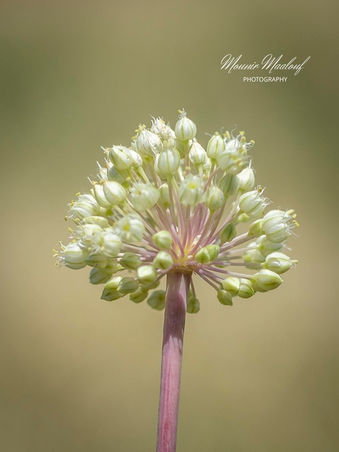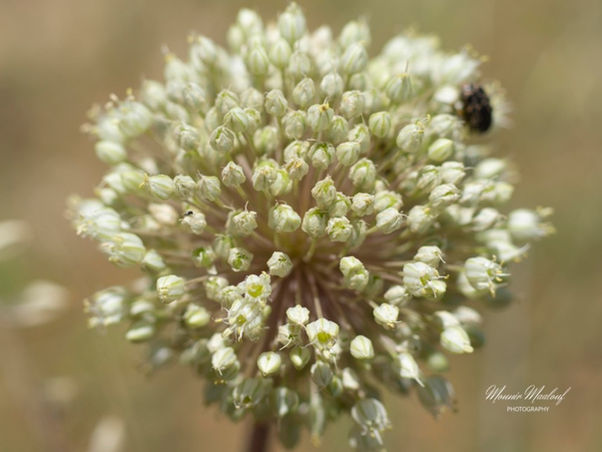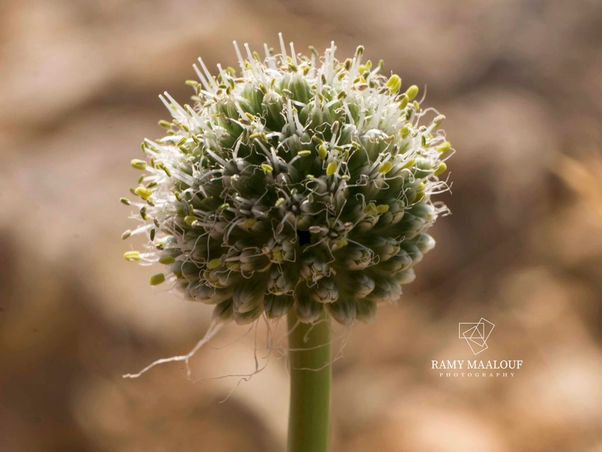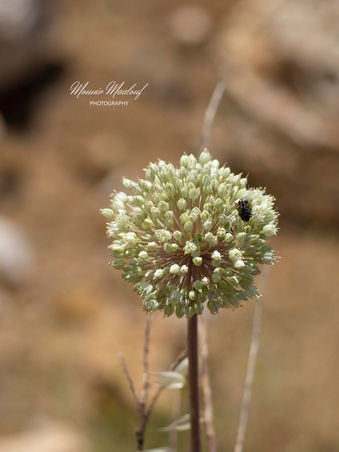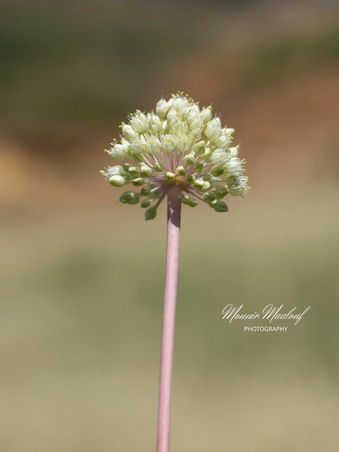Family |
Amaryllidaceae
Allium leucanthum
K.Koch
Allium leucanthum K.Koch
syn. Allium ampeloprasum var. leucanthum (C. Koch) Regel
(Nouvelle Flore du Liban et de la Syrie, vol. 1, Pl. LXXXII nº 3; 1966) Mouterde Complete
Taxonomic note : Father Mouterde treats Allium leucanthum as the white‑flowered variety var. leucanthum of A. ampeloprasum.
Life‑form & habit : Very tall, stout perennial leek, often exceeding 1.5 m; scape cylindrical, glaucous and leaf‑clad to mid‑height.
Leaves : Broadly linear‑lanceolate blades with scabrous leaf sheaths, a key character distinguishing the variety.
Umbel : Very large, subspherical, many‑flowered (up to ca 10 cm across), held on a long peduncle.
Flowers : Pure white; perianth campanulate, 4 – 5 mm; tepals keeled and slightly rough along the keel.
Reproductive organs : Style conspicuously exserted beyond the stamens; anthers small, yellowish to pale.
Flowering period : April – July (as in the typical species).
Habitat & ecology : Prefers higher‑altitude sites, often near cultivated plots or open woodland clearings, unlike the lowland, ruderal habitats of the typical form.
Native range : Scattered upland stations in Lebanon and western Syria, mirroring the overall range of A. ampeloprasum but confined to the cooler mountain belt.
The Unfinished Story of Allium leucanthum: Taxonomic Uncertainty and Systematic Gaps
Allium leucanthum K.Koch, a bulbous geophyte first described in 1849, exemplifies the complexities of taxonomic interpretation in the genus Allium. Traditionally treated as a variety of A. ampeloprasum — notably in regional floras such as Mouterde’s Nouvelle flore du Liban et de la Syrie — this Caucasian onion has recently regained recognition as a distinct species by Kew’s Plants of the World Online (POWO). This article examines the discordant classifications through morphological, molecular, ecological, and phytochemical lenses, and highlights the need for integrative approaches in plant systematics.
Taxonomic Controversy: Species vs. Varietal Status
POWO’s Recognition as a Valid Species
POWO currently lists A. leucanthum as a distinct species (POWO, 2023), though it does not provide morphological descriptions. Morphological traits distinguishing A. leucanthum from A. ampeloprasum are derived from regional floras of the Caucasus and herbarium records (e.g., Grossheim, 1940; Vvedensky, 1935; GAT 0016768, JACQ, 2011):
Bulb morphology: Ovoid-globular bulbs with a grayish-brown outer tunic and yellowish bulbils.
Filament structure: Outer filaments triangular-subulate and ciliate; inner filaments tripartite.
Tepals: White with a green central vein, obtuse or acute.
Leaves: 4–7 linear, keeled, significantly shorter than the scape.
Scape: Erect, 50–100 cm tall.
Habitat: Restricted to arid steppes and rocky slopes in the Caucasus.
These traits are corroborated by herbarium specimens collected in Armenia at approximately 1,610 m elevation (e.g., GAT 0016768).
Mouterde’s Levantine Interpretation
Mouterde (1966) treated Allium leucanthum as the white-flowered variety A. ampeloprasum var. leucanthum. His diagnosis includes the following morphological and ecological traits:
Life form & habit: Very tall, stout perennial leek, often exceeding 1.5 m; scape cylindrical, glaucous, and leaf-clad to mid-height.
Leaves: Broadly linear-lanceolate blades with scabrous leaf sheaths, a key character distinguishing the variety.
Umbel: Very large, subspherical, many-flowered (up to ca. 10 cm across), held on a long peduncle.
Flowers: Pure white; perianth campanulate, 4–5 mm; tepals keeled and slightly rough along the keel.
Reproductive organs: Style conspicuously exserted beyond the stamens; anthers small, yellowish to pale.
Flowering period: April–July (as in the typical species).
Habitat & ecology: Prefers higher-altitude sites, often near cultivated plots or open woodland clearings, unlike the lowland, ruderal habitats of the typical form.
Local distribution: Scattered upland stations in Lebanon and western Syria, confined to the cooler mountain belt.
This reflects the mid-20th-century "lumping" approach, where local variants were subsumed under broader complexes.
Citizen Science Challenges
Recent iNaturalist records from Adana and Hatay (Turkey), and Latakia (Syria), display morphology consistent with A. leucanthum. Nonetheless, the platform follows Flora Gallica (2014) and Hirschegger et al. (2010), maintaining these plants under the broader A. ampeloprasum complex and flagging A. leucanthum as a taxonomic deviation. This highlights the gap between updated institutional databases like POWO and crowd-sourced platforms.
Molecular and Ecological Insights Phylogenetic Ambiguity
Hirschegger et al. (2010) analyzed ITS and chloroplast (trnL–trnF) markers across 30 Allium species. Their study revealed:
99.2% ITS sequence similarity between A. leucanthum and A. ampeloprasum,
Chloroplast haplotype clustering with A. scorodoprasum,
Recommendation to treat A. leucanthum as a subspecies due to low genetic divergence.
In contrast, Khedim et al. (2020) detected unique ITS ribotypes in A. leucanthum, associated with polyploid groups such as Great Headed Garlic. This finding suggests evolutionary independence and supports its species status.
Ecological Divergence
Allium leucanthum exhibits distinct ecological preferences:
In the Caucasus: Arid steppes, sandy soils, and cultivated fields,
In the Levant: Rocky montane habitats at higher elevations.
Such habitat divergence raises the possibility of cryptic speciation or local adaptation.
Biochemical Distinctiveness
Secondary metabolites further support separation. Mskhiladze et al. (2008) identified bioactive compounds in A. leucanthum absent from A. ampeloprasum:
Leucospiroside A: A spirostanol saponin with cytotoxicity against A549 and DLD-1 cancer cells (IC₅₀: 3.7–5.8 μM),
Antifungal activity: Effective against Candida albicans (MIC: 32 μg/mL),
Antileishmanial effects: Saponin fractions inhibited Leishmania major (IC₅₀: 12.5 μg/mL).
While secondary metabolites are taxonomically supportive rather than determinative, these findings reinforce the plant’s biochemical individuality.
Conservation and Nomenclatural Implications
IUCN Status: Recognizing A. leucanthum at the species level could prompt its evaluation for a threatened category, particularly due to its restricted Caucasian distribution.
Range Verification: Observations in Syria and Turkey require ground-truthing to distinguish native stands from human-mediated introductions or misidentifications.
Cytogenetics: Polyploidy (possibly 4x) is suspected but unconfirmed. Chromosome counts would clarify reproductive isolation from diploid A. ampeloprasum.
Outstanding Knowledge Gaps
Integrative Taxonomy: Combining RAD-seq data, morphometrics, and ecological niche modeling is necessary to resolve species boundaries.
Herbarium Revisions: Lebanese herbarium specimens attributed to A. leucanthum require molecular reassessment.
Hybridization Risk: The potential for gene flow with cultivated A. ampeloprasum in overlapping areas merits investigation.
Conclusion
Allium leucanthum straddles a fine line between morphological divergence and genetic similarity. While molecular data suggest a close relationship with A. ampeloprasum, its unique ecological, biochemical, and phylogenetic traits support provisional species status. Comprehensive revision — including field studies, herbarium audits, and cytogenetic analyses — is essential to refine its taxonomy and guide conservation priorities.
